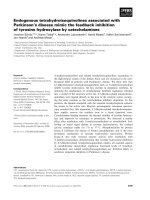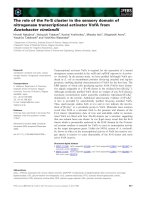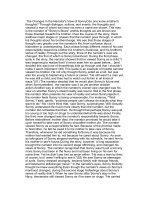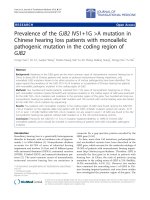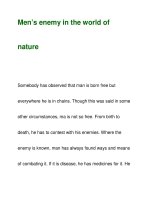Combining DEMO models with RAD's techniques in the analysis phase of software development process
Bạn đang xem bản rút gọn của tài liệu. Xem và tải ngay bản đầy đủ của tài liệu tại đây (140.45 KB, 4 trang )
Combining DEMO models with RAD's techniques in
the analysis phase of software development process
Nguyen Hoang Thuan
Faculty Computer Science
Can Tho In-service University
256 Nguyen Van Cu, CanTho city
Jan L.G.Dietz
Faculty EEMCS
Delft University of Technology,
4 Mekelweg, Delft, The Netherlands
Tran Van Lang
Vietnam Academy of Science and
Technology
Abstract—the software development process needs to be improved
due to the high failure rate of software projects. In main reasons
of this failure, there are two reasons, the first one is lacking of
business process modeling, and the second one is poor
requirements definition in the software development process,
which are however not satisfactorily resolved yet. This paper
analyses the potentials to solve these issues by combining RAD
(Rapid Application Development) and DEMO (Design and
Engineering Methodology for Organizations). In particular, it
creates a new framework for the analysis phase of RAD. It is
shown that the new framework can capture the business process
modeling of the organization before developing its supporting
information systems. In addition, by comparing between the
requirements definition with the business processes, the new
framework can improve the requirements definition in the
software project.
Framework, business process modeling, Software requirements
definition, Rapid Application Development (RAD), Design and
Engineering Methodology for Organizations (DEMO)
I. INTRODUCTION
The failure rate of software development processes is still
high. According to Joseph Barjis [1], this rate keeps increasing
in the last two decades. The data from the survey of Stadish
Group [2] stated that only 29% of all software projects
succeeded. In main reasons of this failure, there are two reasons,
the first one is lacking of business process modeling, and the
second one is poor requirements definition. Determining the
correct software requirements is the key factor behind the
success of every software development project. Nevertheless,
defining exactly what to build is still very difficult.
Although RAD is a good candidate to solve these problems
since it increases the interaction between the analysts and the
users, RAD does not provide enough support for the business
process modeling. Thus, it is necessary to add the business
process modeling tools to RAD. Joseph Barjis [1] introduced the
DEMO transaction concept as a way to construct business
process modeling. In his conclusions, he stated that
“requirements are specified in the form of transactions”. It
means that applying DEMO methodology can model the
business activities of the organization and improve the software
requirement definition process. It is therefore interesting to
explore how DEMO can contribute to the software development
methodology. This leads to the following assignment, construct
a framework combining DEMO models with RAD’s analysis
techniques in order to improve the business process modeling
and requirement definition issue.
Recently, there are many researches tried to solve these two
issues. In short, they can be grouped into two directions. The
first direction is to improve the ability to manage the
requirements definition, including managing the requirements
[4], increasing its traceability [5], [6] and develop the tools for
writing requirements specification. This one is mainly
concerning the techniques to define the requirements. Our
approach fits in the second direction whose purpose is to
validate the specified requirement definition [7], [8], [9]. This
approach has a wider picture which relates the requirements
definition technique with other activities in the software
development lifecycles. The major difference between our
framework and other approaches is that it builds on DEMO
theory which focuses on the ontological level of the business
activities. By comparing between the requirements definition
with the business processes (captured by DEMO model), the
new framework can improve the requirements definition for the
supporting information systems.
The outline of the paper is as follows. Section 2 provides a
summary of the relevant parts of RAD and DEMO, necessary
and sufficient for understanding the rest of the paper. In section
3, a framework in which DEMO models are added to the
analysis phase of RAD is built. Through this combination, the
new framework can capture the business process of an
organization and improve the software requirements definition.
Finally, Section 4 contains the conclusions that can be drawn
from this paper.
II. B
ACKGROUND
A. The analysis phase in RAD
The focus of the analysis phase is on “what the system will
do from the users' perspective?”[10]. In this part, the analysts try
to understand the current system and the requirements from the
users to develop a concept for the new system. There are five
steps performing in this phase
1
: requirements definition, activity
diagram, use case, structure modeling (Class diagram) and
behavioral modeling (Sequence diagram).
Although business process modeling plays a very important
role in the analysis phase, it does not receive enough focus in
RAD. In the past, the analysis phase [10] has no step for the
1
RAD from Alan Dennis and Barbara [11] is introduced in this paper
978-1-4244-8073-9/10/$26.00 ©2010 IEEE
business process modeling. Recently, Alan Dennis and Barbara
[11] used the activity diagram for this purpose. However,
activity diagram does not solve the business process modeling
issue completely. It does not have the actor concept which
clearly shows who is responsible for an activity in the
organization. It is also impossible to show that there are some
activities which are performed by the outside actors, but these
activities have impacts on the operation of our organization.
B. The Interaction Model and Process Model in DEMO
DEMO methodology has a set of models including:
Construction Model (CM), Process Model (PM), Action Model
(AM) and State Model (SM). In more detail level, The CM is
divided into two models: Interaction Model (IAM) and
Interstriction Model (ISM). The Interaction Model and the
Process Model that can be used to model the business process of
the organization will be introduced here.
The Interaction Model: The IAM includes the Transaction
Result Table (TRT) and the Actor Transaction Diagram (ATD).
All the transactions of the organization should be identified in
the TRT and ATD. It also shows the mutual influencing through
different transactions. Because it shows only the very concise
form of the organization, analysts can have a deep
understanding about its operation. In addition, through the IAM,
we can have a clear idea about the competence, authorization
and responsibility of the actors. Therefore, it can help to link the
organizational functions to the supporting information system.
Process Model: By applying transaction pattern to every
transaction identified in the IAM, the PM shows the casual and
conditional relationships between different steps of the related
transactions. Capturing the business processes of the
organization, it can be used as the starting point to design the
supporting system for the organization. Combining with IAM,
the PM can help to map out the organizational functions with
the requirements for the information system in this organization.
III. DEMO
-RAD
FRAMEWORK
In this part, we will introduce a new framework (Figure 1) in
which DEMO models are added to improve the analysis phase
of RAD. As mention above, the activity diagram in RAD does
not completely solve the business process modeling issue, while
the IAM and PM can handle it. Therefore, they will be used to
replace the activity diagram. Besides, an additional step
(Updating requirements definition) will help to check the
requirement definition and to make sure that they are completed.
There are seven steps in the framework: Requirements
definition, Interaction Model, DEMO Process Model, Update
Requirements Definition (Mapping table), Use case, Class
diagram and Sequence diagram. The exchanged information
between these steps will be expressed in the rectangles:
Requirements List, Process Steps and Class & Object
Information. The details of the framework will be clarified in
the latter parts
2
. Within each step, we will introduce the
techniques which can be used, the results and its added values in
the software development process.
2
Only new steps and modified steps will be clarified in the section.
Details of RAD and DEMO steps can be read in [11] and [14]
Figure 1. : DEMO - RAD framework
A. Requirements definition
This step helps the analysts have a clear view of the “to be
built” system, and how this system can support the organization.
The main aim of this step is to collect enough information for
the IM and the PM. In addition, a list of requirements for the “to
be built” system is defined. This list will be checked and
updated later by Updating requirements definition step.
B. Interaction Model
Technique: According to [12], all available documents are
materials to develop the IAM. It means that besides the list of
requirements from the previous step, other organization's
documents should also be reviewed. In this framework, a
storyline about operations will be used to develop the IAM.
Here is the procedure used in this step
• Extract the information about the operation of this
organization from the available documents.
• Focus on the interactions between the stakeholders.
• Translate these interactions into a storyline which
describes the main operation of this organization.
• Apply the three analyses and three syntheses steps [12]
to the story line.
• Check and update the IAM according to the
stakeholders of the organization to make sure that we
capture the completed business process.
Results: On the one hand, IAM (TRT and ATD) is the result
of this step. On the other hand, the comprehensive knowledge
about the operation of this organization will contribute to the
successful rate of the project.
Added value: By using above five steps, the IAM can be
developed. It can help to improve the operation of the
organization by redesigning and reengineering the business. In
other words, before building an information system to support
the operation of an organization, the IAM can help to improve
the efficiency of this organization itself. After this step, we can
make sure that the “to be built” information system will support
the “up to date” organization, not the “out of date” one.
With the IAM, the analysts and the users will have a
comprehensive knowledge of the organization’s operation.
Therefore, the user can really show what he expects on the
future system and the analysts will have a tool which can help
him communicate more effectively with the users.
Finally, because the ATD is abstract, it will be stable
throughout the changes in the organization. As a result, although
the information system needs to be updated from time to time,
its functions can be mapped with the ATD which are quite
stable. In short, it increases the ability to support our
organization in a dynamic environment.
C. DEMO Process Model
Technique: The PM can be created by applying the
transaction pattern [12] to every transaction in the ATD. Every
transaction will be translated into more detailed steps. Then, the
causal and conditional links between these steps will be
identified. Finally, the steps in related transactions can be
grouped in a diagram so that their relationship will be shown.
Results: The PM is a result of this step. Through this model,
the analysts can have the business process of this organization.
Added value: The PM can capture the business process of an
organization. According to [12], it can show “the structure of the
business process” which is lost when using “current process
modeling”. This is one of the reasons why we use DEMO
models instead of Activity Diagram as original RAD procedure.
The completeness characteristic of the transaction means
that “once you have found a P-act/result or a C-act/result, you
can be sure that you have found a complete transaction” [12].
When we define software requirements using other techniques,
there are some cases where requirements are omitted. With this
characteristic of the PM, we can check whether we missed some
requirements. Therefore we can clarify the missing parts.
D. Update Requirements Definition (Mapping table)
This step uses the mapping table to make sure that our list of
requirements is completed. The idea of this step is to map out
the steps in the PM with the requirements which we identified in
the requirements definition step. By discovering the missing
requirements, the analysts can add the additional requirements
for the system.
Technique: The analysts fulfill the following table by using
steps in the PM and requirements definition list. There are six
columns in the following table
TABLE I. MAPPING TABLE
Transa
c
tions
Steps Condi
tions
Supported by
“to be built”
system
Requir
ements
Note
T0x
3
T0x–r
q
Y
R
y
4
R
y
is a
requirement
supporting
T0x–rq
T0x–
pr
T
Performed
tacitly
T0x-ex
N
Do not
support by
the IS
T0x–s
t
Y
?? Missed a
requirement
T0x–ac
N
1. Transactions: This column will list all the transactions
from the ATD
2. Steps: For each transaction, steps column presents all its
steps from the PM.
3. Conditions: Describes the conditions are required in
order to perform this step.
4. Supported by “to be built” system: The decision which
value will be put in the column comes from the analysts.
Depending on whether the "to be built" system will
support the corresponding step or not, this column will
show three types of value: Y, N and T.
o Y (Yes): Supported by the “to be built”
system. It means that there are corresponding
function(s) in the “to be built” information
system which supports this step. In other
words, there should be requirement(s) in the
corresponding requirement column.
o N (No): Not supported by the “to be built”
system. Sometimes a certain step will be done
by human being without software. Another
case for “N” is that this step will be completed
by an outside actor. With these kinds of steps,
there is no need to provide any requirement.
o T (Perform tacitly): Normally, there are many
situations that we communicate tacitly. In a
transaction, promise and accept steps are often
performed tacitly. With these kinds of step,
there is no requirement. However, we need to
take them into account. In case there is too
much miscommunication in these steps, we
should improve them with a corresponding
functions and this column will become Y.
5. Requirements: They are requirements chosen from the
requirement definition step. They are put in a row which
is corresponding to the transaction step in the same row.
This is the column where we really map the detailed
steps from PM with the requirements. In every detailed
3
x: The number of a certain transaction, such as T01, T02
4
y: A certain requirement, such as V01, V02
step of the PM, we will check whether the "to be built"
system provides the support for this step and what is this
support in terms of concrete requirements.
o If the value of the “Supported by “to be built”
system” cell is Y,then the corresponding
“requirements” cell will be fulfilled with
requirement(s). However, if there is no
corresponding requirement in the list, this
column will be fulfilled with ‘??’. Each row
marked with ‘??’ needs to be reviewed in the
later part.
o If the value of the “Supported by “to be built”
system” cell is N or T, there is no need for
any requirement in this row. Therefore, the
corresponding “requirement” cell is empty.
6. Note: This column is used to put any remark for the
corresponding row
After finishing the mapping table, rows with ‘??’ in the
requirement column need to be reviewed and additional
requirements can be added in the list of requirements.
Results: The mapping table is a result of this phase. On the
basis of the mapping table, the software requirements will be
updated. From this time, the requirements can support the main
business processes of this organization.
Added value: With the mapping, we have a complete list of
requirements which can be used to support our business process.
The mapping table increases the requirements traceability.
When we want to update a requirement, we can trace back
which business function this requirement will support. As a
result, the related requirements in this business function should
be reviewed for updating.
E. Use case
According to Boris Shishkov and Dietz [17], DEMO model
can be used to directly map with the use-case in such a way that
all essential behavior will be captured. Therefore, in this step,
we will first derive use case based on DEMO and then,
complete it with traditional RAD's technique. This will make
sure that our use case is consistent. It not only captures the
essential business activities but also provides enough details for
developing other models in the later step.
After the above mentioned steps in the framework, the class
diagram and sequence diagram still need to be developed in
order to finish the analysis phase. These diagrams can be
developed based on RAD’s technique [11]
IV. C
ONCLUSION AND FUTURE RESEARCH
The high rate of software failure in the past, due to poor
requirement definitions, forces us to review the RAD process.
We discovered the activity diagram in RAD procedure is the
step needs to be improved. Therefore, we have developed a new
framework for the analysis phase of the software development
process where we combined the IAM and the PM with the
traditional RAD technique. In every modified phase of the new
framework, we discussed the techniques we would use, its
results and added values.
By combining DEMO models and RAD’s technique in the
above framework, we can deal with the difficulties in defining
software requirements and business process modeling. DEMO
can help capture the business processes of the organization
while RAD technique links these business processes to the
software development concepts (requirements, use case).
Besides, using this framework, the business processes can be
optimized before transferring to a complete list of requirements
and use case model. In addition, by focusing on the abstract
level of DEMO models, the operation of this organization can
be easily understood and managed to deal with the change in the
environment. It also helps the business side and the analyst side
increase the understanding and communication about the system
by mapping between the business functions and the
requirements for the “to be built” system.
There are many possibilities to extend our work. One of
them is to add other DEMO models to the framework, such as
Action Model (AM) and State Model (SM). According to [7],
AM can specify the “business rules” of the organization while
the SM shows the “data dictionary” of an enterprise. Thus,
combining these models into the framework and evaluating this
combination could be an extension for our work.
V. R
EFERENCES
1. Barjis, Joseph, The importance of business process modeling in
software systems design. Science Direct. 2008
2. The Standish Group International. 2004 Third quarter research
report. s.l. : The Standish Group International, 2004.
3. May, Lorin J. Major causes of software project failures. [Online].
/>. 1998
4. Borlands. Effective Requirements Definition and Management.
5. Ian Spence, Leslee Probasco. Traceability Strategies for Managing
Requirements with Use Cases.
6. Dean Leffingwell, Don Widrig. The Role of Requirements
Traceability in System Development.
7. M. Lemoine, D. Marre, P. Thuillier and J L. Wippler. Validating
requirements: the evolutionary approach.
8. Rombach, Erik Kamsties and H. Dieter. A Framework for
Evaluating System and Software Requirements Specification
Approaches.
9. F.Sequeda, Juan. A Taxonomy of Verification and Validation of
Software Requirement and Specifications.
10. Dennis, Barbara HaleyWixom. Systems Analysis & Design. 2003.
Second edition.
11. Dennis, Barbara Haley Wixom and David Tegarden. Systems
Analysis & Design with UML Version 2.0. 2009. Third edition.
12. Dietz, Jan L.G. Enterprise ontology: Theory and Methodology.
Berlin : New York : Springer, 2005.
13. Dietz, Jan L.G. The deep structure of business process 2006.
14. Dietz, Jan L.G and Han Schouten. Modeling Business Processes
for Web-based Information Systems Development.
15 Deriving use cases from business process models. 2003.
16. Paul Mallens, Dietz, Jan L.G, Bart-Jan Hommes. The Value of
Business Process Modeling With DEMO Prior to Information
Systems Modeling With UML.
17. Dietz, Jan L.G, Boris Shishkov and Deriving use cases from
business processes: The advantages of DEMO. 2004.
